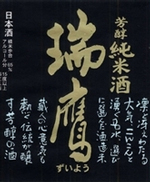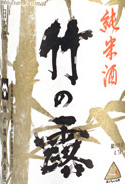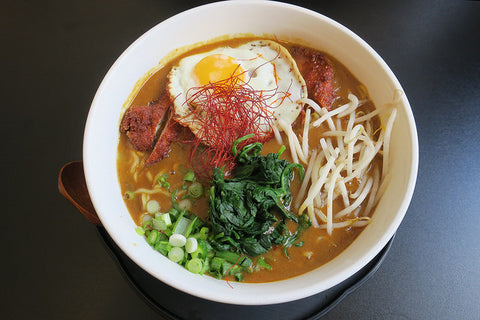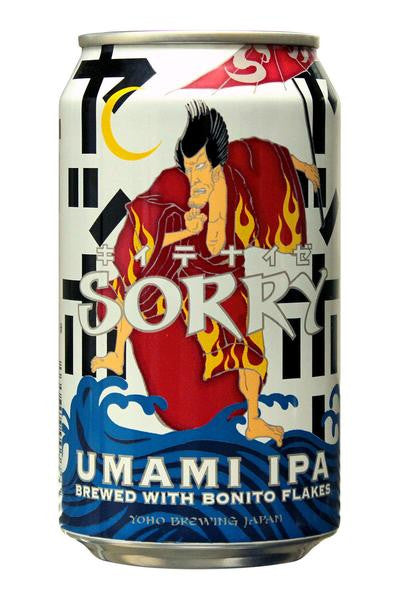 September sakes ship today for Sake Gumi, our monthly sake subscription club. If you like what's on deck here, you should join!
September sakes ship today for Sake Gumi, our monthly sake subscription club. If you like what's on deck here, you should join!
One of the most common questions we get at the store is “What is Umami?” So I wanted to explore umami this month in the context of Sake Gumi.
All of the sakes this month were chosen to exhibit how umami plays an important role in sake, and chosen for their umami-rich profiles. One of the defining characteristics of sake, apart from other fermented beverages, such as wine and beer, is that it is rich in amino acids and glutamates – which our tastebuds perceive as umami. Umami is the fifth element of taste after sweet, salty, bitter, and sour. While food with sodium tastes salty and food with quinine tastes bitter, food high in glutamates tastes of umami.
“Umami” derives from the Japanese characters 旨い (
umai; delicious) and 味 (
mi; taste). It was discovered in 1908 by Dr. Kikunae Ikeda, who wanted to pinpoint the flavor present in his daily bowl of miso soup. He was then able to isolate the glutamic acid from
konbu that is used to make
dashi for the soup. Umami was officially recognized as one of the five basic taste senses by the international scientific community in 1985 and is best defined as meaty, brothy, and mouth-watering.
Sakes that are rich in umami are typically
junmais as opposed to
honjozos,
ginjos, and
daiginjos. Sake makers intentionally brew
junmais to be rich in umami to pair well with hearty foods, like meats and stews. They achieve this by using certain yeasts during fermentation and leaving more of the outer layer of the rice grain when polishing.
When enjoying sake, we can enhance its inherent umami by warming it. Warming sake gently to body temperature (98°F) highlights umami while subduing its bitterness and acidity. I have included a section on the other side of this sheet on how to warm sake. Try it!
Yoko
LEVEL 1: Introductory Membership (Two 300ml bottles)
 Hojun Zuiyo Junmai
Hojun Zuiyo Junmai
Zuiyo Co., Ltd. (Kumamoto, Japan)
Seimaibuai: 65%
SMV: +5
This well-balanced sake from Southern Japan is soft and smooth with hints of tropical fruit. This is a good example of a sake that has a clear, brothy, umami flavor without being over-the-top rich. I enjoyed drinking this sake at
room temperature and then
warmed up with some
roasted sweet bell peppers and
sauteed shiitake.
 Jozen Noujun Junmai
Jozen Noujun Junmai
Shirataki Sake Brewery (Niigata, Japan)
Seimaibuai: 80%
SMV: +2
This sake boldy proclaims its umami. With a rice polishing ratio of 80% (only 20% of the outer layer of the rice is removed), this sake is super robust. It has notes of rum raisin and plum, and a long finish akin to whisky. A spectrum of flavors present in this sake makes it ideal to pair with rich, savory foods like
liver pate and
Salt Fish and Ackee (at
Miss Ollie's around the corner from Umami Mart!). Although the label on the bottle suggests having this chilled, I enjoyed this sake best at
room temperature.
LEVEL 2: Premium Membership (Two 720ml bottles)
 Takenotsuyu Junmai
Takenotsuyu Junmai
Takenotsuyu Sake Brewing Co. (Yamagata, Japan)
Seimaibuai: 60%
SMV: +2
Although Takenotsuyu is the driest, brightest, and fruitiest of the four sakes this month, it still has a mouth-watering brothiness about it that I identify as umami. The initial tart taste of cherries and raspberries morphs into a long finish full of umami. Try this sake at
room temperature with
grilled fish or
steamed shellfish.
Warming it up softens the tang but creates a shorter, clean finish.
 Tsuzumi Junmai
Tsuzumi Junmai
Onda Shuzo Co. Ltd. (Niigata, Japan)
Seimaibuai: 48%
SMV: -2
This is one of my favorite sakes of the moment. It smells and tastes like many of my favorite foods: mushrooms, caramelized onions, and bourbon. With a solid sweetness, this sake pairs well with spicy foods like
curried meats or
Korean chicken wings (twice fried!). I’m also content to savor the long finish of this creamy, viscous brew by itself,
slightly warmed. Note that the rice is polished down to 48% (52% removed), yet the brewer still names this a
junmai. (Rice that is polished 50% or more is typically used for brewing
daiginjo grade sakes.)
SG Tip: How to Warm Sake
1) Transfer sake into
tokkuri (sake flask)
2) Bring pot of water to boil (water in pot must reach at least half the height of the
tokkuri)
3) Turn heat off.
4) Place
tokkuri into the pot for 5 min.
5) Enjoy!
 September sakes ship today for Sake Gumi, our monthly sake subscription club. If you like what's on deck here, you should join!
One of the most common questions we get at the store is “What is Umami?” So I wanted to explore umami this month in the context of Sake Gumi.
All of the sakes this month were chosen to exhibit how umami plays an important role in sake, and chosen for their umami-rich profiles. One of the defining characteristics of sake, apart from other fermented beverages, such as wine and beer, is that it is rich in amino acids and glutamates – which our tastebuds perceive as umami. Umami is the fifth element of taste after sweet, salty, bitter, and sour. While food with sodium tastes salty and food with quinine tastes bitter, food high in glutamates tastes of umami.
“Umami” derives from the Japanese characters 旨い (umai; delicious) and 味 (mi; taste). It was discovered in 1908 by Dr. Kikunae Ikeda, who wanted to pinpoint the flavor present in his daily bowl of miso soup. He was then able to isolate the glutamic acid from konbu that is used to make dashi for the soup. Umami was officially recognized as one of the five basic taste senses by the international scientific community in 1985 and is best defined as meaty, brothy, and mouth-watering.
Sakes that are rich in umami are typically junmais as opposed to honjozos, ginjos, and daiginjos. Sake makers intentionally brew junmais to be rich in umami to pair well with hearty foods, like meats and stews. They achieve this by using certain yeasts during fermentation and leaving more of the outer layer of the rice grain when polishing.
When enjoying sake, we can enhance its inherent umami by warming it. Warming sake gently to body temperature (98°F) highlights umami while subduing its bitterness and acidity. I have included a section on the other side of this sheet on how to warm sake. Try it!
Yoko
LEVEL 1: Introductory Membership (Two 300ml bottles)
September sakes ship today for Sake Gumi, our monthly sake subscription club. If you like what's on deck here, you should join!
One of the most common questions we get at the store is “What is Umami?” So I wanted to explore umami this month in the context of Sake Gumi.
All of the sakes this month were chosen to exhibit how umami plays an important role in sake, and chosen for their umami-rich profiles. One of the defining characteristics of sake, apart from other fermented beverages, such as wine and beer, is that it is rich in amino acids and glutamates – which our tastebuds perceive as umami. Umami is the fifth element of taste after sweet, salty, bitter, and sour. While food with sodium tastes salty and food with quinine tastes bitter, food high in glutamates tastes of umami.
“Umami” derives from the Japanese characters 旨い (umai; delicious) and 味 (mi; taste). It was discovered in 1908 by Dr. Kikunae Ikeda, who wanted to pinpoint the flavor present in his daily bowl of miso soup. He was then able to isolate the glutamic acid from konbu that is used to make dashi for the soup. Umami was officially recognized as one of the five basic taste senses by the international scientific community in 1985 and is best defined as meaty, brothy, and mouth-watering.
Sakes that are rich in umami are typically junmais as opposed to honjozos, ginjos, and daiginjos. Sake makers intentionally brew junmais to be rich in umami to pair well with hearty foods, like meats and stews. They achieve this by using certain yeasts during fermentation and leaving more of the outer layer of the rice grain when polishing.
When enjoying sake, we can enhance its inherent umami by warming it. Warming sake gently to body temperature (98°F) highlights umami while subduing its bitterness and acidity. I have included a section on the other side of this sheet on how to warm sake. Try it!
Yoko
LEVEL 1: Introductory Membership (Two 300ml bottles)
 Hojun Zuiyo Junmai
Zuiyo Co., Ltd. (Kumamoto, Japan)
Seimaibuai: 65%
SMV: +5
This well-balanced sake from Southern Japan is soft and smooth with hints of tropical fruit. This is a good example of a sake that has a clear, brothy, umami flavor without being over-the-top rich. I enjoyed drinking this sake at room temperature and then warmed up with some roasted sweet bell peppers and sauteed shiitake.
Hojun Zuiyo Junmai
Zuiyo Co., Ltd. (Kumamoto, Japan)
Seimaibuai: 65%
SMV: +5
This well-balanced sake from Southern Japan is soft and smooth with hints of tropical fruit. This is a good example of a sake that has a clear, brothy, umami flavor without being over-the-top rich. I enjoyed drinking this sake at room temperature and then warmed up with some roasted sweet bell peppers and sauteed shiitake.
 Jozen Noujun Junmai
Shirataki Sake Brewery (Niigata, Japan)
Seimaibuai: 80%
SMV: +2
This sake boldy proclaims its umami. With a rice polishing ratio of 80% (only 20% of the outer layer of the rice is removed), this sake is super robust. It has notes of rum raisin and plum, and a long finish akin to whisky. A spectrum of flavors present in this sake makes it ideal to pair with rich, savory foods like liver pate and Salt Fish and Ackee (at Miss Ollie's around the corner from Umami Mart!). Although the label on the bottle suggests having this chilled, I enjoyed this sake best at room temperature.
LEVEL 2: Premium Membership (Two 720ml bottles)
Jozen Noujun Junmai
Shirataki Sake Brewery (Niigata, Japan)
Seimaibuai: 80%
SMV: +2
This sake boldy proclaims its umami. With a rice polishing ratio of 80% (only 20% of the outer layer of the rice is removed), this sake is super robust. It has notes of rum raisin and plum, and a long finish akin to whisky. A spectrum of flavors present in this sake makes it ideal to pair with rich, savory foods like liver pate and Salt Fish and Ackee (at Miss Ollie's around the corner from Umami Mart!). Although the label on the bottle suggests having this chilled, I enjoyed this sake best at room temperature.
LEVEL 2: Premium Membership (Two 720ml bottles)
 Takenotsuyu Junmai
Takenotsuyu Sake Brewing Co. (Yamagata, Japan)
Seimaibuai: 60%
SMV: +2
Although Takenotsuyu is the driest, brightest, and fruitiest of the four sakes this month, it still has a mouth-watering brothiness about it that I identify as umami. The initial tart taste of cherries and raspberries morphs into a long finish full of umami. Try this sake at room temperature with grilled fish or steamed shellfish. Warming it up softens the tang but creates a shorter, clean finish.
Takenotsuyu Junmai
Takenotsuyu Sake Brewing Co. (Yamagata, Japan)
Seimaibuai: 60%
SMV: +2
Although Takenotsuyu is the driest, brightest, and fruitiest of the four sakes this month, it still has a mouth-watering brothiness about it that I identify as umami. The initial tart taste of cherries and raspberries morphs into a long finish full of umami. Try this sake at room temperature with grilled fish or steamed shellfish. Warming it up softens the tang but creates a shorter, clean finish.
 Tsuzumi Junmai
Onda Shuzo Co. Ltd. (Niigata, Japan)
Seimaibuai: 48%
SMV: -2
This is one of my favorite sakes of the moment. It smells and tastes like many of my favorite foods: mushrooms, caramelized onions, and bourbon. With a solid sweetness, this sake pairs well with spicy foods like curried meats or Korean chicken wings (twice fried!). I’m also content to savor the long finish of this creamy, viscous brew by itself, slightly warmed. Note that the rice is polished down to 48% (52% removed), yet the brewer still names this a junmai. (Rice that is polished 50% or more is typically used for brewing daiginjo grade sakes.)
SG Tip: How to Warm Sake
1) Transfer sake into tokkuri (sake flask)
2) Bring pot of water to boil (water in pot must reach at least half the height of the tokkuri)
3) Turn heat off.
4) Place tokkuri into the pot for 5 min.
5) Enjoy!
Tsuzumi Junmai
Onda Shuzo Co. Ltd. (Niigata, Japan)
Seimaibuai: 48%
SMV: -2
This is one of my favorite sakes of the moment. It smells and tastes like many of my favorite foods: mushrooms, caramelized onions, and bourbon. With a solid sweetness, this sake pairs well with spicy foods like curried meats or Korean chicken wings (twice fried!). I’m also content to savor the long finish of this creamy, viscous brew by itself, slightly warmed. Note that the rice is polished down to 48% (52% removed), yet the brewer still names this a junmai. (Rice that is polished 50% or more is typically used for brewing daiginjo grade sakes.)
SG Tip: How to Warm Sake
1) Transfer sake into tokkuri (sake flask)
2) Bring pot of water to boil (water in pot must reach at least half the height of the tokkuri)
3) Turn heat off.
4) Place tokkuri into the pot for 5 min.
5) Enjoy!




Comments (0)
There are no comments for this article. Be the first one to leave a message!